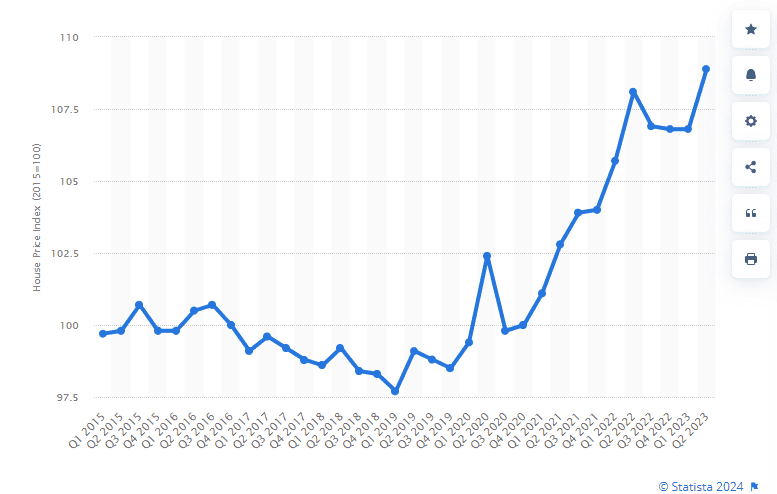italy
Property Market Overview

Historical Prices and Trends
Pre-2000s
Before the 2000s, the Italian property market was relatively stable, with moderate price increases driven by steady economic growth and a strong cultural attachment to homeownership. The market was characterised by local demand, with less interest from international investors.
2000-2007
Between 2000 and 2007, Italy experienced a property boom. Prices surged due to several factors:
- Economic Growth: A period of economic expansion boosted consumer confidence.
- Low Interest Rates: Access to affordable mortgages encouraged property purchases.
- Euro Introduction: The euro adoption 1999 provided economic stability and attracted foreign investment.
During this period, property prices in major cities like Rome, Milan, and Florence substantially increased, with annual growth rates exceeding 5%.
2008-2013
The global financial crisis of 2008 significantly impacted the Italian property market. Key trends during this period include:
- Price Decline: Property values fell sharply, averaging 20-30% declines from peak levels.
- Decreased Demand: Economic uncertainty and tighter lending criteria reduced the number of buyers.
- Rising Inventory: An oversupply of properties, particularly in new developments, further pressured prices.
By 2013, the market had reached its lowest point, with prices bottoming out after several years of decline.
2014-2019
The recovery phase began around 2014, characterised by:
- Slow Recovery: Prices stabilised and gradually increased, particularly in major urban centres.
- Increased Foreign Investment: Attractive property prices and favourable exchange rates drew interest from international buyers.
- Urban Renewal: Revitalization projects in cities like Milan spurred local market growth.
While the recovery was uneven, with more robust performance in northern cities and tourist hotspots, overall market sentiment improved.
2020-Present
The COVID-19 pandemic in 2020 introduced new dynamics to the Italian property market:
- Pandemic Impact: Initial uncertainty caused a temporary slowdown, but the market quickly adapted.
- Rural and Suburban Demand: Increased interest in rural and suburban properties emerged as remote work became more prevalent.
- Government Incentives: Stimulus measures and incentives for property renovations supported market activity.
Despite the pandemic, the market demonstrated resilience, with prices in desirable locations continuing to rise.
Current Trends
As of 2024, several key trends define the Italian property market:
- Urban Demand: Major cities like Milan and Rome remain attractive to domestic and international buyers.
- Sustainability: Energy-efficient and sustainable properties are increasingly sought after.
- Tourism Influence: High demand in tourist areas such as Tuscany and the Amalfi Coast continues to drive property prices.
- Technological Adoption: Digital tools and online platforms transform property transactions and market transparency.
The Italian property market has experienced significant fluctuations over the past two decades, from its stability before 2000 through the boom, crisis, and recovery phases. Current trends indicate a resilient market with opportunities driven by urban demand, sustainability, and technological adoption.
Average Prices:
- National average: €2,850 (US$3,100) per sqm (May 2024)
- Significant regional variations: Major cities like Milan (€4,986/sqm) and Venice (€4,415/sqm) are more expensive. Southern regions generally see lower prices.
Price Forecasts:
- 2024: 1-3% appreciation expected
- Varies by city, higher in economic hubs
Taxes on Property Investment in Italy
Purchase Taxes
Registration Tax (Imposta di Registro)
When purchasing a property in Italy, investors must pay a registration tax. For first homes, the rate is 2% of the property’s cadastral value. For second homes, the rate increases to 9%. If the property is purchased from a company, VAT may apply instead.
Value-Added Tax (VAT)
VAT is applicable when buying a property from a developer or a company. The standard rate is 10%, but it increases to 22% for luxury properties. First-time homebuyers may be eligible for a reduced rate of 4%.
Mortgage Registration Tax (Imposta Ipotecaria)
This tax is charged when registering a mortgage. The rate is typically 0.25% of the mortgage amount for first homes and 2% for second homes.
Cadastral Tax (Imposta Catastale)
Cadastral tax is due at the time of purchase. The standard rate is a fixed fee of €50 for first homes and 1% of the property’s cadastral value for second homes.
Annual Taxes
Municipal Property Tax (IMU)
IMU is an annual property tax applied to second homes and luxury first homes. The rates range from 0.4% to 1.06% of the cadastral value, depending on the municipality. Primary residences (non-luxury) are generally exempt.
Service Tax (TASI)
TASI covers municipal services and is payable by both owners and tenants. The rate varies by municipality but typically ranges from 0.1% to 0.25% of the cadastral value. Primary residences are usually exempt.
Waste Collection Tax (TARI)
TARI is an annual tax for waste collection services. The amount depends on the property’s size and the number of occupants.
Capital Gains Tax (CGT)
When selling a property, investors are liable for capital gains tax if the property is sold within five years of purchase. The standard rate is 26% on the gain. Properties held for more than five years are exempt from CGT.
Income Tax on Rental Income
Rental income from properties is subject to income tax. The tax rates are progressive, ranging from 23% to 43%. Alternatively, landlords can opt for the “Cedolare Secca” flat tax, which offers a rate of 21% for long-term leases and 10% for agreements with subsidized rents.
Inheritance and Gift Tax
Inheritance and gift tax rates depend on the relationship between the donor and the recipient. Spouses and direct descendants pay 4% on amounts exceeding €1 million. Siblings pay 6% on amounts over €100,000, while other relatives pay 6% with no threshold. Non-relatives are taxed at 8% with no threshold.
Conclusion
Investing in the Italian property market involves several taxes, including purchase taxes such as registration tax, VAT, mortgage registration tax, and cadastral tax. Annual taxes include IMU, TASI, and TARI. Additionally, investors must consider capital gains tax, income tax on rental income, and inheritance and gift tax. Understanding these tax obligations is essential for effective property investment in Italy.
Investment Hotspots
Milan: Italy’s financial hub offers solid rental yields and robust property value growth. Its thriving business environment and cultural attractions make it a top investor choice.
Rome: The capital city boasts a rich historical and cultural heritage—Rome’s property market benefits from steady demand, particularly in central and tourist-heavy areas.
Florence: Known for its art and architecture, it attracts tourists and students, driving demand for short-term rentals and student housing.
Tuscany: The region’s scenic landscapes and historic towns, such as Siena and Lucca, make it a popular choice for vacation homes and agritourism investments.
Venice: Despite periodic flooding, Venice remains a prime location for high-end property investments due to its unique appeal and tourist draw.
Turin: As an industrial and technological hub, Turin offers affordable property prices with potential for appreciation, particularly in revitalized areas.
Promising Areas:
Puglia: This southern region is gaining popularity for its beautiful coastlines and historic towns. Properties here are relatively affordable, with increasing interest from international buyers.
Investment Considerations:
Rental Demand:
- Short-term/tourism rentals popular in historic cities
- Rising demand for affordable long-term rentals
- Student housing is undersupplied in university towns
Challenges:
- Bureaucracy and legal difficulties
- Construction costs and skilled labour shortages
- Tax regime, including wealth taxes
- Many older properties require renovation
We provide foreign investors with exclusive access to Italian real estate. With local expertise and insider connections, we offer prestigious off-market opportunities. From elite addresses to high-yield rentals, we tailor solutions to your investment goals, ensuring a distinguished ownership experience in a top real estate market.

Property deal sourcing – Everything You Need To Know
Deal sourcers act as property hunters. They search for undervalued or overlooked properties that can generate significant returns. These professionals use multiple methods to find deals




